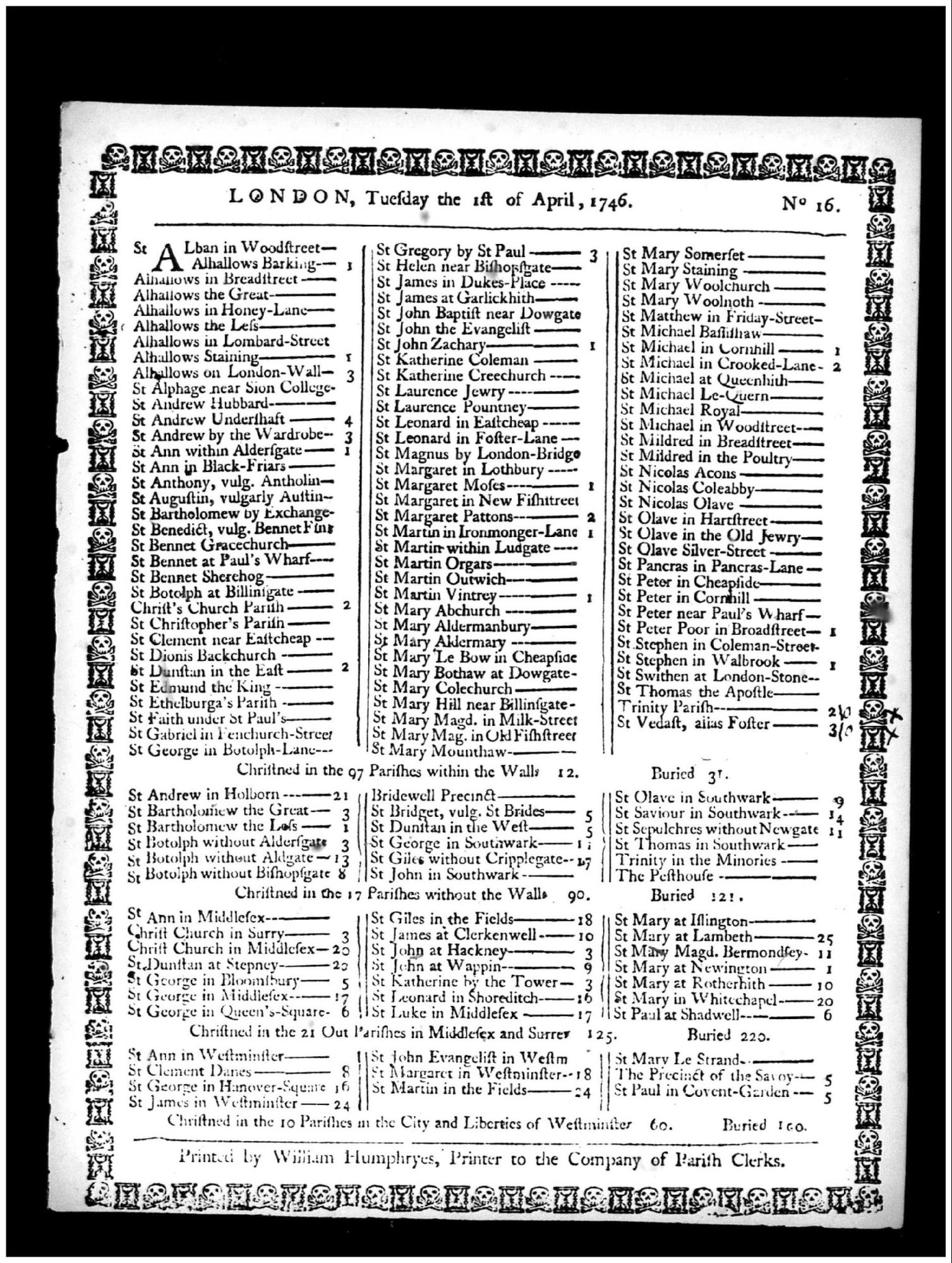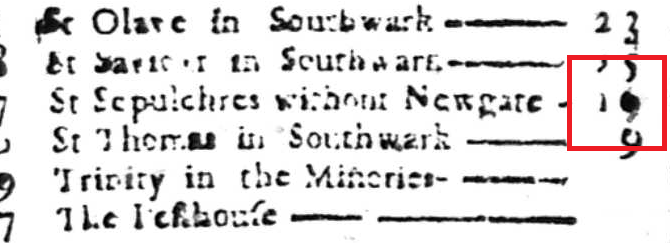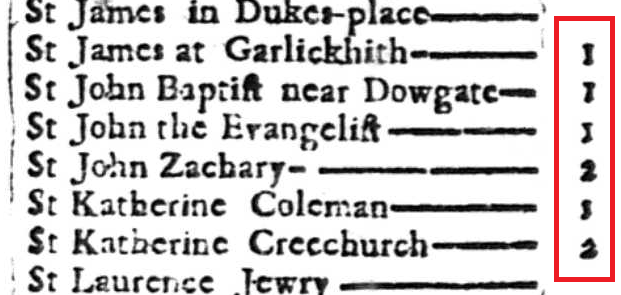| September 10, 2024
Ambiguous Bills and Anonymous Commentators: Reflections on My Experience Transcribing the Bills of Mortality
I have had the pleasure over the last several months of transcribing Bills of Mortality for the Death by Numbers team, and what initially most surprised me is the amount of interpretation my role requires. Just because the bills are what historians would describe as “primary sources,” transcribing them is more complicated than just copying them word-for-word.
While it helps that the original bills are in English, I still routinely run into textual issues that require me to pause and think carefully and critically about how to approach the text. In this blog post, I want to give readers a peek into my world, so they can see the transcription issues I face on a regular basis. Before I end, I will offer a brief list of strategies I have learned that have helped me tackle transcription issues. I will also challenge you, dear reader, with three recent examples from my work to test your mettle as a transcriber. I encourage you to reply to this post with your ideas about how you would deal with them.
If I am going to share my world with you, I want to start with something positive and interesting before dwelling on the challenges of the job. To be completely honest, what I enjoy the most is finding memorable deaths. Oftentimes, they are so interesting that I cannot stop myself from sharing them with friends and family. Here are five examples to show you what I mean. I have included screenshots of the original text and, if you want to look for them yourself, my footnotes mention their dates.
- Death from itch1

Figure 1. Death from itch
- Rupture and being scalded in a brewer’s mash2

Figure 2. Rupture and being scalded in a brewer’s mash
- Chimney collapse3

Figure 3. Chimney collapse
- A falling church bell4

Figure 4. A falling church bell

Figure 5. Found dead in a sewer
As one might expect, stumbling upon memorable deaths like these is rare. Most of my time as a transcriber involves carefully sifting through numbers of deaths in each of early modern London’s parishes. If a death grabs my attention, I take a few minutes to research it, which inevitably leads to interesting, and sometimes surprising, details about life in London at that time.
Take my last example above. The bill indicates that a man’s body was found in a sewer at “St. Katharine near the Tower.” With that in mind, a quick search leads me to a Wikipedia page about that location, the Royal Hospital and Collegiate Church of St. Katharine by the Tower, which was next to the Tower of London.7 While I do not consider Wikipedia to be a definitive source, it can be useful for the informal research I like to do while transcribing bills.
If I would continue my search, I would go back into the bills for references to drowning deaths and suicides at St. Katharine’s Parish. I believe I found several of those in the bills a few months ago. Going even further, I could look into conditions in the Royal Hospital and try to find information about overall numbers of patients and even accounts of their experiences.
The example I just described should give you a sense of my workflow. Typically, it is rare for me to find memorable deaths, so most of my pauses deal with issues in texts. Sometimes, they are more complicated than I initially assume. For instance, the screenshot below is of a bill I recently transcribed dating back to the 1st of April of 1746.8

Figure 6. A section of a bill from April 1st, 1746 with what look like handwritten comments on it
I remember my initial reaction to the section I highlighted in the screenshot above. I saw the Xs and assumed someone wrote them because there was a mistake in the printed numbers: the two and three on the left of the horizontal lines are incorrect. That means that the zeros to the right are correct and there were no deaths in Trinity and St. Foster parishes. After consulting other members of the Death by Numbers team, however, I abandoned my initial interpretation and went with the two and three to the left of the horizontal lines.
In retrospect, I learned something important working through this transcription issue: I need to be more careful when interpreting handwritten comments. I know nothing about the person who wrote them. Looking at the image of the entire bill below, I do not see any information about the anonymous commentator.9 How can I confirm that that person is a reliable source on the deaths in Trinity and St. Foster?

Figure 7. The entire bill from April 1st, 1746
Moreover, why should I feel confident about how I interpreted the comments. Why am I assuming that one person made them? There may have been two commentators, one who wrote the Xs and one who wrote the zeros. I can imagine different scenarios in which they wrote their comments. Maybe the first commentator wrote the Xs to highlight that there was an issue in that part of the bill. Then later, a second commentator wrote the horizontal line and the zeros to correct the bill. Alternatively, the second commentator may have written the Xs to indicate that the first commentator’s zeros are incorrect. Unfortunately, this is the only time I have seen Xs like this in the bills, so I do not have previous examples on which to rely.
Now that I have shared an example of my thought process, let me shift focus to you. Earlier I mentioned that I have three examples for readers of this post to transcribe. My hope is that you will get in touch with me with a reply.
- The first example comes from a bill from 1717 that looks like it may have been altered.10 Note how the numbers in the red box in the screenshot below seem to be much clearer and sharper than the other numbers on the page. Is that a coincidence from the quality of the digital scan or the original document, or did someone touch them up? In other words, does the image indicate the numbers are originals or did someone change them?

Figure 8. Are the numbers in the red box originals or have they been touched up?
- The second example is from a bill from 1741.11 Is the number in the red box in the screenshot below a 16 or a 19? Did 16 or 19 people die in the parish?

Figure 9. Is that a 16 or a 19?
- The third example comes from another bill from 1741.12 What are the numbers in the red box below? Do you think they are handwritten or printed?

Figure 10. Are those numbers ones, twos, threes, eights?
Finally, here is the list of strategies I mentioned earlier. I compiled them based on my experience transcribing the bills on my own and my conversations with the Death by Numbers team.
- Do not rush.
- I am often tempted after reading several bills with similar formatting to speed up my process. That is when I need to slow down or take a break so I do not miss important details.
- Leverage the source material.
- This has been an important point for me. A regular part of my transcription process is referring back to previous bills to help me make decisions about a section that is unclear or ambiguous.
- Reach out for help.
- This is something I did more frequently when I first started as a transcriber. I was lucky to be on a team with experienced transcribers, who would share their experience and wisdom when I had issues with the text. Of course, I did not want to waste their time, so initially I tried to come up with a solution on my own, which I would include in my request for help.
- Check each other’s work.
- The way we work in the Death by Numbers project is to check each other’s work. When I finish a transcription, a second person reviews it. If a page is especially difficult or I do not feel as focused as I should be, I like to take a short break after finishing it and return for a full review.
- Take notes.
- I always keep a text editor open while I am transcribing, so I can keep track of issues to which I want to return later. This is particularly helpful when I want to leave comments about a bill when I submit it. If I record them clearly enough while I am transcribing, all I need to do is copy and paste them into a comment box. Then, I can move ahead to the next bill.
February 6th, 1665 (Bodleian-1665-08) ↩︎
February 14th, 1664 (Bodleian-1664-09) ↩︎
March 28th, 1676 (1676-16-Bodleian) ↩︎
December 26th, 1676 (1676-02-Bodleian) ↩︎
March 13th, 1665 (Bodleian-1665-13) ↩︎
March 13th, 1665 (Bodleian-1665-13) ↩︎
“Royal Foundation of St Katharine,” Wikipedia, August 28, 2024. ↩︎
April 1st, 1746 (1746-16-Laxton) ↩︎
April 1st, 1746 (1746-16-Laxton) ↩︎
September 10th, 1717 (1717-39-Laxton) ↩︎
January 12th, 1741 (1741-04-Laxton) ↩︎
January 19th, 1741 (1741-05-Laxton) ↩︎